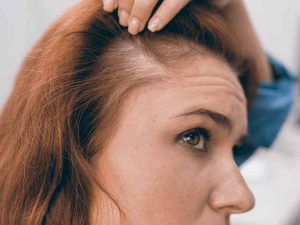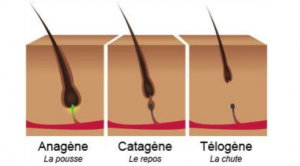Hair loss in men and women

Hair loss in men and women today represents a major problem in the social life of those who suffer from it. It can sometimes lead to severe depression and a feeling of loss of self-confidence. It is said that today about 40% of people suffer from this pathology and that the problem worsens considerably after 50 years.
Although it seems strange, the average individual loses an average of between 100 hairs per day, a figure that can even reach 200 hairs in the fall.
But this is part of the usual hair regeneration process which is done every 6 months.
Hair loss that forms over the years is part of the gradual hair loss process. Then we will see what are the different important things you need to know about alopecia.
We will first look at the different stages of hair growth before focusing on the cause of hair loss.
The different stages of hair growth

The Anagen phase
This is the hair growth phase. The hair bulb regenerates, its cells multiply allowing the hair to grow at the rate of one centimeter per month. This phase lasts between 1 and 3 or 4 years and will determine the length of the hair. Depending on its location on the scalp, the hair follicle does not have the same growth rate. Its growth is faster in the upper part of the skull than in the temples.
The Catagen phase
This is the phase of stopping hair growth. The cells of the matrix stop multiplying, the follicle retracts to the surface of the scalp. This phase allows the hair to prepare for the resting phase, which lasts about 3 weeks but can sometimes last several months.
The Telogen phase
This phase begins with this period of rest where the hair no longer grows but remains attached to its follicle. The bulb is on the surface of the scalp. In 2 to 4 months, the hair gradually falls out to give way to the formation of new hair.
Thus the hair grows in successive phases, each hair follicle knows between 25 and 30 cycles during its life until exhaustion.
Specialists specify that 90% of hair is permanently in the growth phase and 10% in the fall phase.
What is alopecia?
Hair loss in men and women, Alopecia, or also known as baldness, is a gradual loss of hair on the scalp that can lead to permanent hair loss.
It affects the entire population, continues to affect mostly men – around 50% – but also affects women – around 30%.
It is not only a cosmetic problem but it can also psychologically affect the people who suffer from it. That’s why it’s good to treat this common disease like any other.
The causes of alopecia
The causes of hair loss in men and women can be very diverse and numerous, however the most common are:
Androgenetic alopecia
This type of alopecia, as its number indicates, is a genetic pathology that appears after the age of fifty in both men and women. But it can also appear much earlier since it is a lot of people. Causes progressive hair loss. It could be due to hormonal changes, health issues, stress, or even a poor diet.
Bad nutrition
Gradual and slow hair loss is generally linked to a poor diet and therefore to a crucial lack of vitamins or nutrients essential to the good health of our scalp.
The stress
Excessive stress related to work or complicated situations to manage can also cause hair loss and this is noticed when our body, feeling threatened, reacts to this type of stress.
Various infections
There are a number of infections that can cause irreversible damage to our scalp and subsequently lead to hair loss, follicle degeneration and loss of hair density.
Hair loss in men and women
The famous “entrances” that terrify people who suffer from hair loss, whether male or female, although more particularly male, are caused by alopecia or baldness.
This disease occurs more frequently in men but more and more we observe its presence in women.
If men are more affected by this disease, it is simply because of the presence of hormones called androgens in the human body. These promote hair loss and that is why men are 70% more affected by alopecia.
When baldness appears, it intervenes in the regeneration cycle of the follicle, thus causing an interruption in hair growth. the follicle moves to the level of the scalp and ends up atrophying.
Hair loss in men and women : Men are more affected at the level of the globes or the temples, hence the presence of thinning hair. It is more common for alopecia to act at this level than at the apex or upper part. In general, even if for some the fall is earlier, it is from the age of 35 that it begins.
The different causes of alopecia in men
Hair loss in men can be due to several reasons, one of which is increased testosterone in the body. This hormone is linked to the male sex, it is she who is responsible for the difference, bone, muscle and sexual.
But over the years and with the advancement of research, it has been shown that certain particularly stressful situations can cause irreversible damage. Like, for example, a breakup, the loss of a job or much more. It is usually the stress caused by this situation.
How to hide hair loss?
Once the damage is done and we find visible entrances in the front of our heads, we naturally try to hide them. And for this there are many techniques.
We are going to give you some techniques that exist and that we have listed that will hide the entries and give you a little more confidence.
The haircut is a very important element to take into account when suffering from baldness.
- The “Caesar” cut: This haircut is really very practical when you want to hide hair loss, it is a question of letting the hair grow behind the hair loss and covering it.
- Complete shaving also allows you to eliminate the problem of baldness. Precisely some world famous actors like VinDiesel or Jason Statham popularized this haircut and even made it attractive and sexy.
- The military-style haircut with a good layering on the sides can also sometimes help hide a receding hairline.
Obviously, it must be taken into account that these are temporary solutions and that the problem related to the fall is not treated as such. If in your case the solution gets worse, we recommend that you resort to a hair transplant.
You can also resort to hair treatments using different similar products or medications to overcome the problem.
Hair loss in women, why?
Over time, we had to face the facts. Alopecia also affects the female sex. Although this number is lower than that of men, it is true that it is still a major problem for women who suffer from it.
In women going through menopause, pre and postpartum periods or body temperature can cause such hair loss in certain areas of the scalp. Indeed, a considerable increase in androgens can be observed during these periods.
In women, alopecia is a real social problem that can lead to a significant lack of self-confidence and generate serious psychological problems, this problem must therefore be taken very seriously.
What solutions to fight against female alopecia?
In the female population, there are many natural products and treatments to combat hair loss or targeted hair loss, there are also pills or tablets that help strengthen and grow hair.
There are some practical tips that can help strengthen your hair on a daily basis, as well as professional hair treatments. We present some of them:
- When you wash your hair, you can rinse with cold water. This will stimulate blood circulation and help strengthen your hair.
- Use a shampoo suitable for your hair type.
- Do not hesitate to use supplements such as biotin or keratin, they are great allies against the thinning of your hair.
- Go see a real professional or a dermatologist who can guide you towards the most appropriate treatment for you.
- Take care of your diet, favor sources of Zinc, Vitamin D or B1 and Iron, avoid fast foods and dishes of this type.
- If your alopecia is a major problem for you and it affects your social life and makes you depressed, opt for hair transplantation.
How to hide female pattern baldness?
It is a possibility that women have a little more than men, thanks to their long hair, they can hide certain areas with low hair density. Sometimes this can be the solution to prevent some women from sinking into depression and cutting off all social ties.
As for men, you can also adopt haircuts that allow you to hide your alopecia more easily.
A trick that is also widely used by women is hair extensions, provided, of course, that you use them correctly and know how to place them. There are also quality wigs that can look stunning and extremely realistic.
Some cosmetics even make it possible to dye the scalp a color similar to that of the hair, creating the illusion of greater density.
As you will have understood, although there are techniques which make it possible to mask or combat alopecia, the most effective and above all definitive treatment is still hair transplantation, for hair loss in men and women
__

Dr. Baykal Oymak is a highly esteemed transplant specialist hailing from Turkey, boasting an impressive 17-year tenure in the medical field. His professional journey commenced as a dermatologist at Bogazici Hospital in Istanbul, where he began to hone his expertise. Since then, Dr. Oymak has conducted a remarkable tally of approximately 14,000 triumphant hair transplant procedures within Turkey. Additionally, he holds specialization in PRP treatment and Mesotherapy, further solidifying his reputation as a versatile and accomplished practitioner in the realm of dermatology and transplantation. » SCHEDULE YOUR HAIR TRANSPLANT IN TURKEY HERE «

[…] of the time this cause concerns men, and we then speak of androgenetic alopecia. And contrary to what one might think, hereditary alopecia comes from the mother. Indeed, the X […]
[…] Hair loss can be a distressing experience, impacting self-esteem and confidence. Fortunately, advancements in medical technology have made hair restoration procedures like hair transplants more accessible and effective than ever before. However, the success of a hair transplant largely depends on one crucial factor: the qualifications and expertise of the surgeon performing the procedure. In a global hub for hair transplants like Istanbul, where countless clinics offer their services, understanding the importance of choosing a qualified Surgeon for Your Hair Transplant is essential for achieving the best possible results. […]